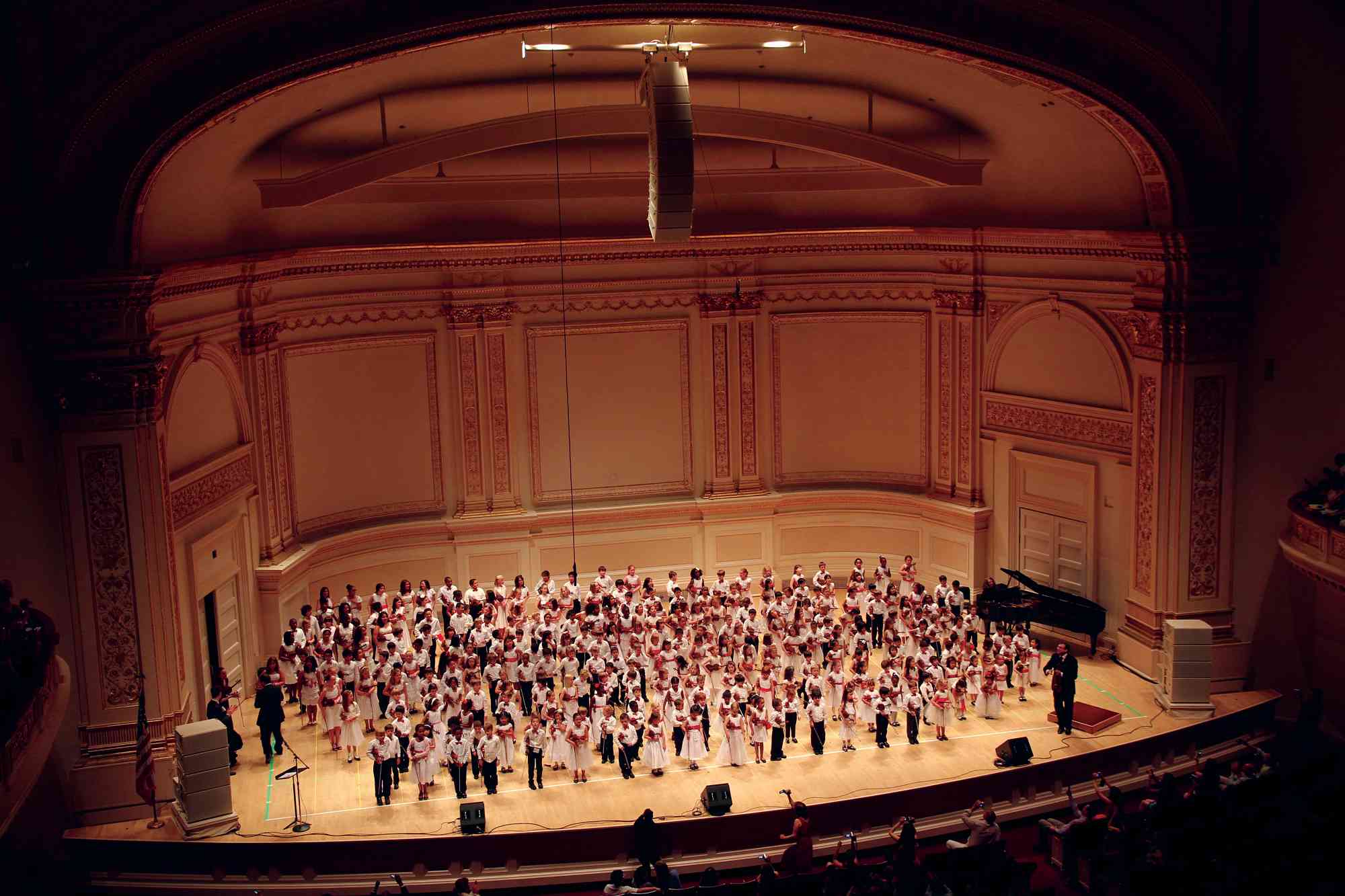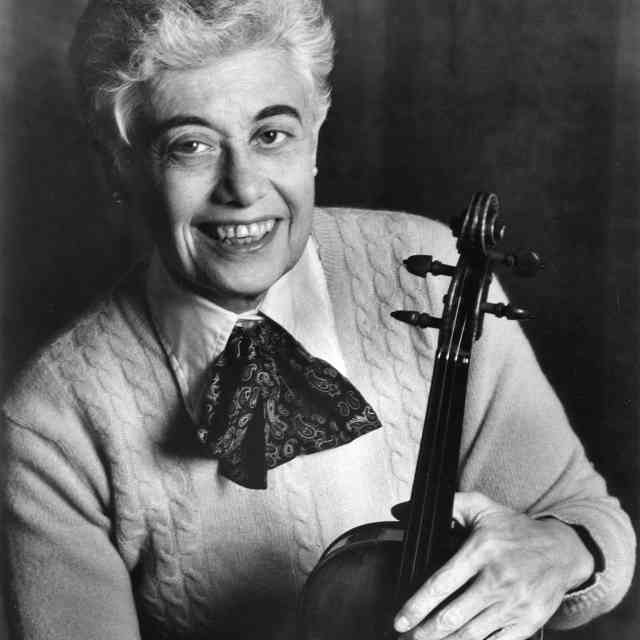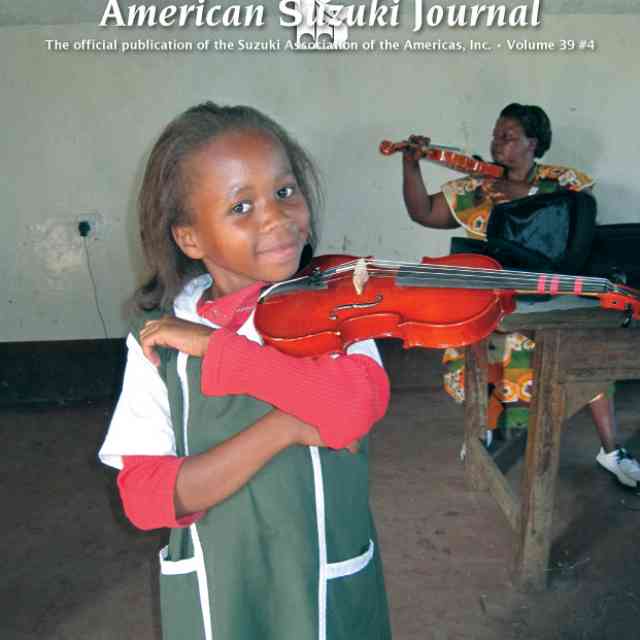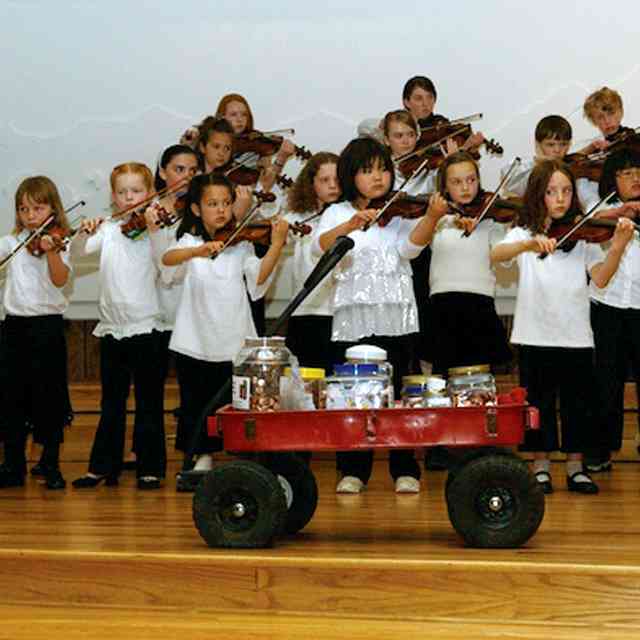The last week of May was a week of 40th Anniversary Celebrations at Carnegie Hall for The School for Strings, the path-breaking Manhattan Suzuki school and teacher training center founded by Louise Behrend.
Wednesday, May 25, the School presented its piano department in two solo recitals in Carnegie’s Weill Recital Hall. Every student in the department was showcased, and they performed to enthusiastic audiences.
Friday afternoon, May 27, the School sponsored a String Festival in Carnegie Hall’s main Isaac Stern Auditorium. All of the School’s violin and cello students, joined by students of the School’s teacher-training graduates, participated, a total of almost 1,000 students.
A surprise and very welcome honored guest at both the piano and the string events was Dr. Mineo Nakajima, president of the Talent Education Research Institute in Matsumoto, Shinichi Suzuki’s own school. Dr. Nakajima made the trip to New York especially to attend The School for Strings’ 40th Anniversary Celebrations. Quoting from the letter he sent to the School after his return home, he said:
I have to tell you how much I enjoyed my trip to New York to celebrate the 40th Anniversary Concerts of The School for Strings at Carnegie Hall. Both the Piano Recitals and the String Concert were very wonderful. All of the children played with happy hearts, and I want to commend you and thank you for all of the work you do for the happiness of children.
I was also pleased to see how much Dr. Suzuki’s ideas and his philosophy have been successfully developed in the United States. I am sure that Dr. Suzuki would be very proud of all that you have accomplished. I myself was very happy to play the violin with American Suzuki children at the world-famous Carnegie Hall.
Congratulations again on all of your fine work, and I hope our paths will cross again in the near future.
We were delighted to have as Master of Ceremonies for the String Festival Suzuki violin teacher and teacher trainer Edmund Sprunger. He wrote to us later:
It’s safe to assume that you all know that old joke about the tourists in New York City they’re probably from the Midwest, maybe Missouri. They’ve lost their way when they spot a guy carrying a violin. In some versions of the story the guy is Mischa Elman; in other versions, it’s Jascha Heifetz. They figure a fellow with a violin must know, so they ask him, “How do you get to Carnegie Hall?” The answer, of course, is “Practice, Practice, Practice!” It’s a good story, but the punch line tells us, really, very little. If you stop to think about what else it takes to get to Carnegie Hall, you could probably write a book. Among other things, getting to Carnegie Hall also takes Vision, Vision, Vision!
Louise Behrend was one person who made a huge difference by working tirelessly to make her vision a reality. The School for Strings began forty years ago as an idea by its founder Louise Behrend. Miss Behrend wanted to establish a center to train teachers in what was then a new approach to music education. It was an approach created by a relatively unknown Japanese violin teacher: Shinichi Suzuki. As a beginning teacher in Michigan in the late 1980s, I wrote Miss Behrend a letter and asked her, “If you could give one piece of advice for a successful Talent Education program in the United States, what would it be?” Her response: “Well-Trained, Enthusiastic Teachers, and Informed and Willing Parents.” Louise was always quick to credit the assistance of others, especially Sheila Keats, with helping to make The School for Strings a going concern. Still, there’s no doubt about the fact that Louise was a major force behind getting almost 1000 skilled young string players to the stage of Carnegie Hall on Friday afternoon, May 27, for the spectacular School for Strings 40th Anniversary Celebration Concert. I was deeply honored to serve as the Master of Ceremonies for that afternoon.
In addition to Practice, Practice, Practice, it took Connect, Connect, Connect. Every one of the performers in that concert had a special connection to The School for Strings. They were current students in the School, alumni of the School, or current students of teachers who graduated from The School for Strings Teacher Training Program, a program that has produced over 500 teacher graduates who are teaching around the world. That number alone is staggering.
I think we’d be hard-pressed to name any other person who was so instrumental in getting so many performers to Carnegie Hall.
Congratulations, Louise!
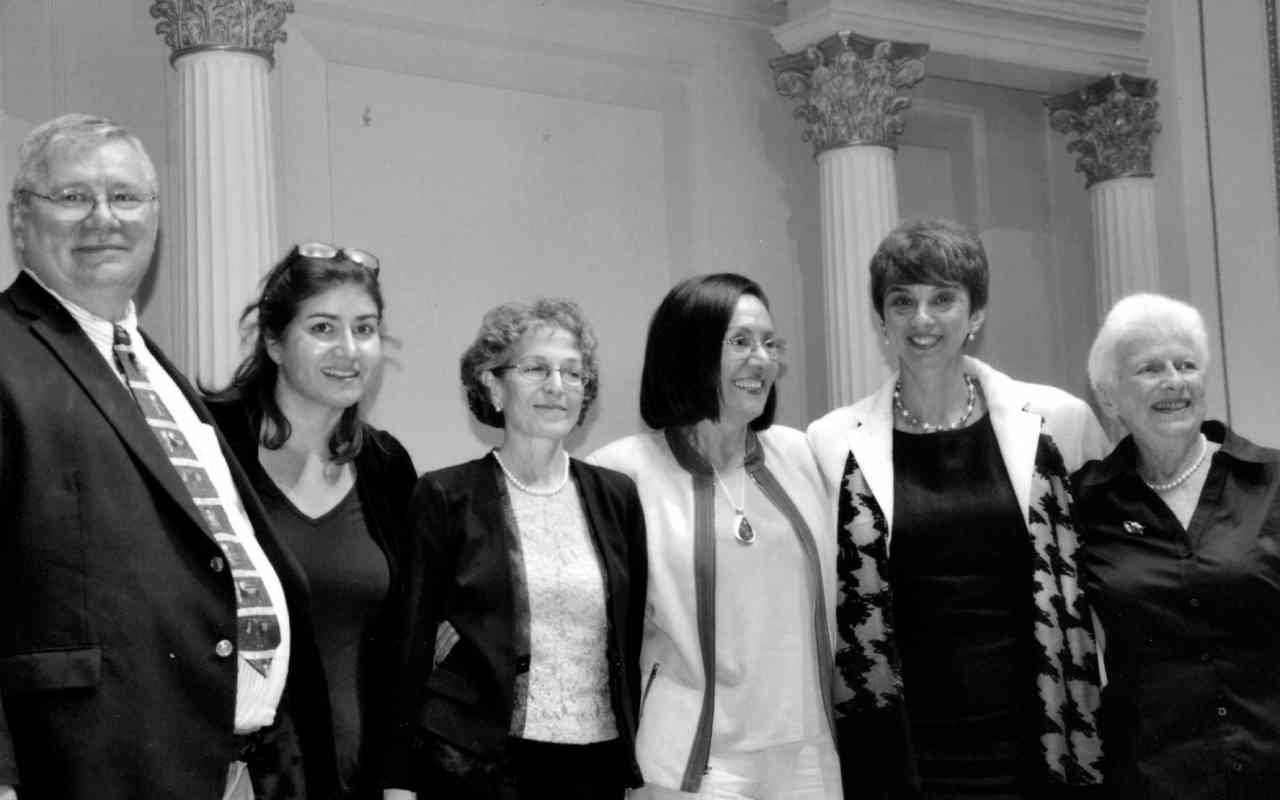
Members of the School for Strings Piano Faculty: David Smithers, Elke Velasquez, Faina Khodos, Maria Pereira, Marina Obukovsky, Shelia Keats
Mary Craig Powell, Suzuki piano teacher and teacher trainer, took a detour on her trip from her home in Ohio to the SAA Memorial Day weekend Leadership Retreat in Texas to attend the SFS Piano Recitals at Weill Hall in New York. Later in the summer, after Louise Behrend’s death, she wrote to us:
The loss of Louise Behrend, one of our renowned pioneers of Suzuki method, has been felt worldwide. Perhaps no one feels this loss any more strongly than the faculty of The School for Strings, the school which Louise founded and developed. Outstanding as a teacher, Louise Behrend was equally outstanding in her visions and development of this fine school of Suzuki instruction in the heart of New York City.
Louise showed her wisdom when she placed the Piano Department under the capable hands of her fine friend, accompanist, and colleague, Sheila Keats. As a result, the piano program joins the string program in thriving there. Ms. Keats has provided the teacher training for all of her piano faculty and the quality of their piano program is exceptional.
It has been my privilege and pleasure to know the piano faculty and its fine work. Not only have I taught their piano students on numerous occasions, but I also had the pleasure of attending their 40th Anniversary Graduation Concert on May 25, 2011, in which all their piano students performed in Carnegie Hall. I was moved by the high quality. I felt as if Suzuki was surely smiling down upon this occasion and saying, “Here is an exceptional example of my philosophy thriving at the piano. Every child can play beautifully—not just a few, but all.”
Louise Behrend has left a strong legacy for The School for Strings. Speaking as a pianist, I am positive her legacy is being fulfilled in that department. They bring honor to all for which Louise stood.
The School for Strings, which grew out of a small Suzuki Program of twenty violin students and three apprentice teachers-in-training, became the first Suzuki-based community music school in the Greater New York area. Today there are countless Suzuki programs in the area, most of them staffed in large part by graduates of the SFS Teacher Training Program. The School is one of the few independent music schools offering long-term teacher training in violin, cello, and piano. Its teacher training graduates are now teaching throughout the United States as well as abroad; the alumni of its program for training children have gone on to study in the country’s top conservatories, colleges, and universities, and to establish themselves successfully in careers in music, law, medicine, and many other fields.
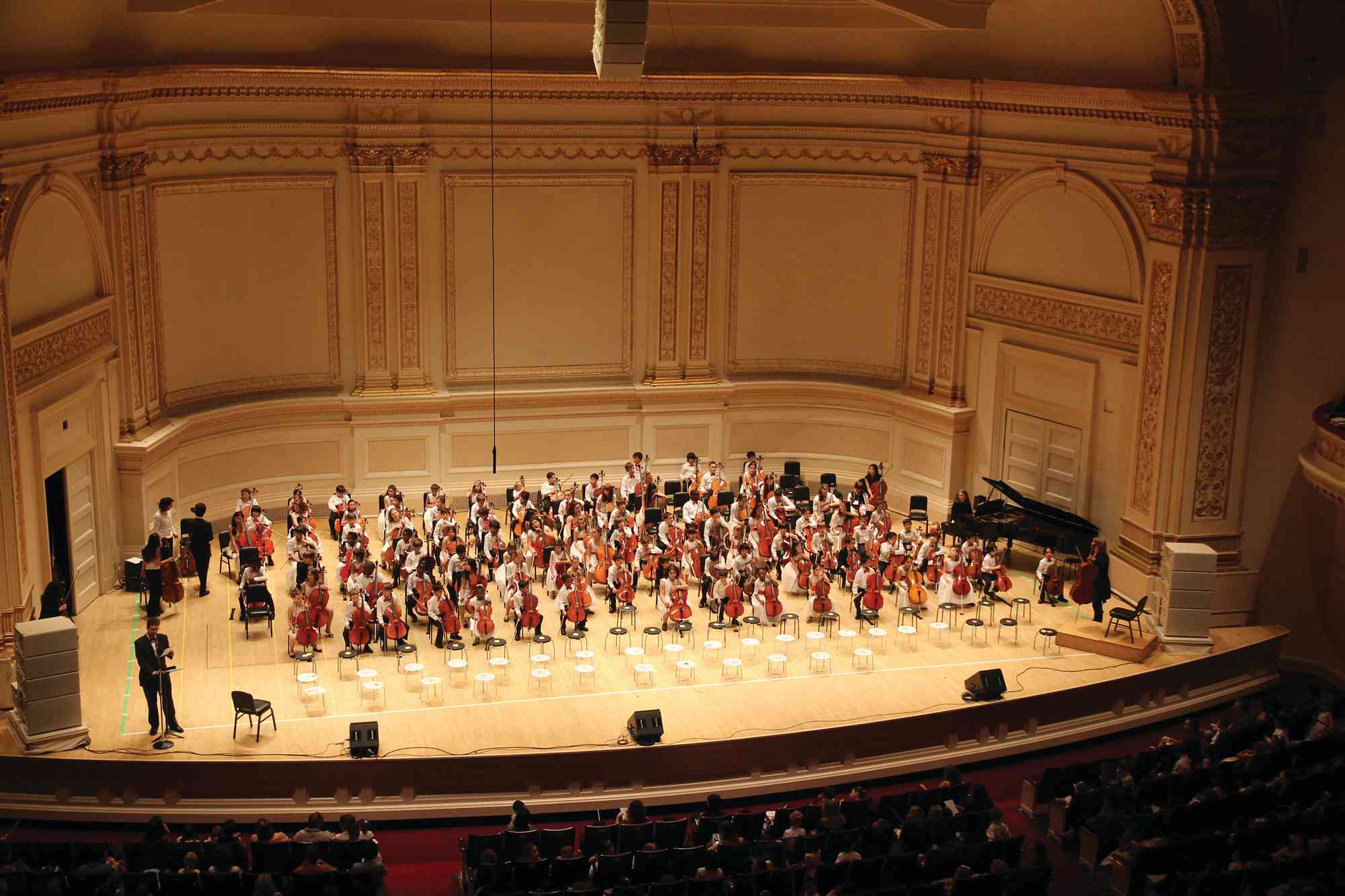
Pam Devenport getting 175 cellists ready for performance as Edmund Sprunger, MC, is addressing the audience at the School for Strings 40th Anniversary Gala Concert
